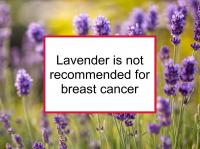English lavender (Lavandula angustifolia) essential oil has been used for centuries to reduce pain, combat infection, reduce anxiety and promote relaxation. Like other essential oils, lavender essential oil is very concentrated; at least 60 lbs of lavender flowers typically are used to make 16 fluid ounces of the oil.
The oil is used in detergents, baked goods, candles, cosmetics, body powder, massage oil, shampoo, soap, perfume, and tea. It is also an ingredient in some breast enlargement pills and creams. Some cancer patients are receiving aromatherapy massage using lavender essential oil.
Breast cancer-related effects of lavender
Lavender essential oil has been shown to have a high antioxidant content. A component of lavender, perillyl alcohol, has been studied in cancer prevention. Lavender essential oil has been reported to reduce cell viability and induce apoptosis (programmed cell death) in both hormone receptor positive (ER+/PR+) and triple negative (ER-/PR-/HER2-) breast cancer cells.
Lavender has estrogenic properties
However, lavender essential oil has estrogenic properties that sometimes can be expressed even at the modest concentrations found in personal care products.
Lavender essential oil (in commercial hair care and body cream products) was reported to cause breast enlargement in otherwise healthy and normal boys in one well-known 2007 New England Journal of Medicine article. A 2015 study described another three cases of boys who presented with prepubertal gynecomastia and who had been chronically exposed to lavender. A 2018 study confirmed the finding of estrogenic effects of lavender-containing skin products. A 2019 California study reported clinical evidence of prepubertal breast development in four children (three girls and one boy) with a history of continuous exposure to lavender-containing fragrances. However, a 2021 study of 556 children found no cases of prepubertal gynecomastia and reported that those who were regularly exposed to lavender essential oil experienced the same risk of endocrine disorders as those without such exposure.
These reports and findings are not without controversy. However, the safest strategy would be to avoid using lavender essential oil, as well as lavender scented products such as skin lotions that are used frequently and are intended to remain on the skin.
Additional comments
Use of lavender products can trigger allergic contact dermatitis and allergic reactions to lavender are not uncommon. For example, lavender flower satchels placed inside pillowcases have been found to cause facial rashes in some individuals.
Sources of information in this webpage
The information above, which is updated continually as new research becomes available, has been developed based solely on the results of academic studies. Clicking on any of the underlined terms will take you to its tag or webpage, which contain more extensive information.
Note that while we are continually searching for new evidence specifically concerning lavender, there is not much interest in it among main stream breast cancer researchers, so few studies directly relevant are available.
